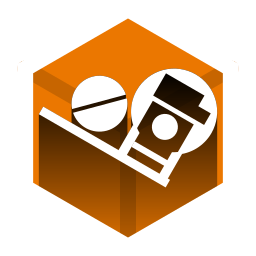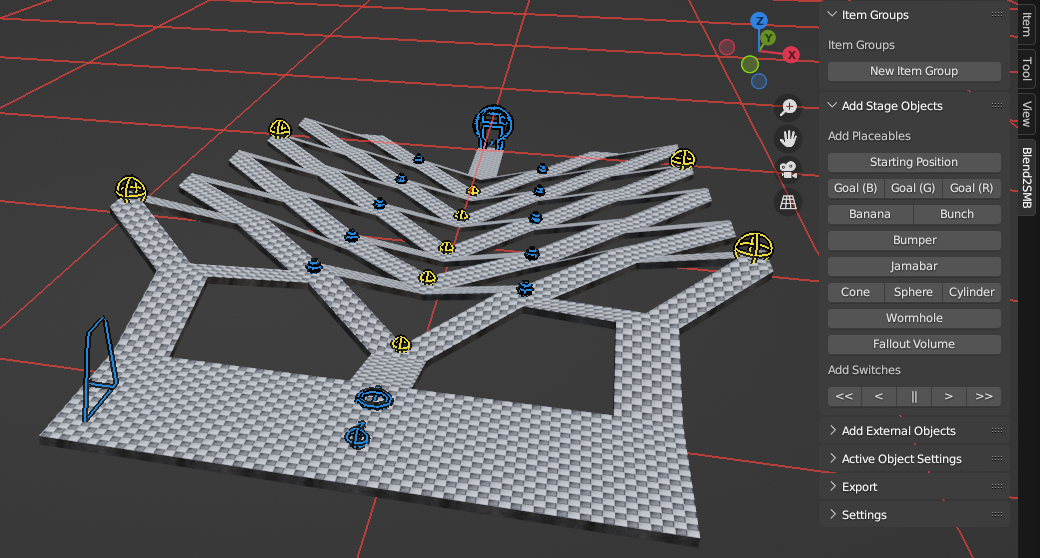BlendToSMBStage2 is a Blender plugin that assists with the creation of custom Super Monkey Ball stages. With this plugin, you can create a 3D model for your stage in Blender, map out item, goal, and starting placements, and then export the model and stage configuration directly into Super Monkey Ball 2. This plugin utilizes the custom level tools SMB Workshop 2 and GxUtils for generating stage configuration and model files compatible with the original game. This plugin started as a re-write and port of CraftedCart's Blend2SMBStage plugin for Blender 2.7x with extended functionality. The original version of the plugin can be found here.
The latest version of CraftedCart's SMB Workshop 2 is built in, but can be separately downloaded here.
The latest version of GxModelViewer is also included, and can be downloaded here.
A guide to the usage of this tool, along with documentation in regards to Monkey Ball modding as a whole, can be found here.
The latest version of the plugin can be downloaded at this link. You do not need to extract the files in the
downloaded .zip file. Open Blender (any version later than 4.1.1), and go to Edit->Preferences in the menu bar.
Go to the 'Add-ons' tab, and select 'Install...'. Navigate to, and select the downloaded .zip file. Search for
"BlendToSMBStage2" in the Add-ons list, and then tick the checkmark next to the addon. The add-on will then be installed.
You can access the stage object functionality through the 'Blend2SMB' tab on the right of the 3D viewport. If you can't
see it, click the grey + icon in the top right of the 3D viewport.
BlendToSMBStage2 depends on certain tools to export files that are seperate from Blender. Because of this, the build
script linux-build.sh has been provided for Linux users. The following dependencies are required, in addition to
standard development tools commonly found in packages such as base-devel on Arch Linux:
cmake dotnet-sdk mono mono-msbuild
qtbase5-dev qttools5-dev libglew-dev libglm-dev libassimp-dev libbullet-dev ninja-build
Clone the repository, and then run the build script. The packaged plugin will be placed into a newly created out
folder upon the completion of the script.
If you want to import an old Blend file from 2.79 or earlier, you will need to convert the file to Cycles in order to get materials to show up properly. You can use the plugin 'Material Utils Special' in 2.79 to achieve this. This is an add-on that can be installed in a default installation of 2.79. You can go to File->User Preferences and locate it in the Add-ons tab. If this process is not done, you'll need to re-assign textures to your stage.
For versions of Blender 2.79 or earlier, linked is a script you can paste into the text editor that takes a folder as input, and converts all of the Blend files in the folder to ones compatible with 2.8. This script uses the 'Material Utils Special' plugin, and it needs to be enabled before running the script. You can modify the folder that is to be used in the text editor.
- Now supports Blender versions 2.80 and higher. Not compatible with 2.79b or earlier versions of Blender.
- Added support for the following stage objects:
- Jamabars
- Cone collision objects
- Sphere collision objects
- Cylinder collision objects
- Animated background objects (including scale keyframes)
- Animated and non-animated foreground objects (including scale keyframes)
- Added the ability to add texture scroll to item groups, background and foreground objects.
- Added the ability to export animation for background and foreground objects. Background and foreground objects support scale keyframe animation.
- A toggle for whether or not goals cast shadows has been added.
- Level models can now have special properties toggled, including casting/receiving shadows, and type A and B transparency.
- Initial animation state and animation type are now selectable from a list.
- Seesaw properties are now configurable for item groups.
- Linking switches to item groups can now be done by selecting the item group empty from a list, rather than using IDs.
- Linking wormholes to other wormholes can now be done by selecting the wormhole empty from a list, rather than using IDs.
- Added visual representations for all stage objects.
- Properties of stage objects have been given more readable names, and are accessible through the 'Active Object Settings' panel.
- Keyframe generation has been optimized, such that redundant keyframes are no longer generated, resulting in reduced file size.
- Keyframe generation timestep can now be defined per item group. Item groups that do not have a defined timestep will use the global setting.
- Defining item groups or other objects as animated is no longer an option. Whether or not an object is animated is determined automatically on export, and is based on present animation channels.
- 'Degenerate Dissolve' is now performed automatically on OBJ export, to reduce the likelihood of zero-area-face-related crashes in Monkey Ball.
- The current frame is automatically set to frame 0 on OBJ export.
- (WS2 change) Setting objects as 'runtime reflective' no longer causes mirror planes to appear darker than normal.
Connecting wormholes has been simplified. In order to link two wormholes together, all that you need to do is select the destination wormhole from the 'Linked' list in the 'Active Object Settings' panel. The wormholes will then be linked. You can link a wormhole to itself, several wormholes to a single wormhole, or a wormhole to another wormhole. A wormhole cannot be unlinked. If you are importing an old Blend file with wormholes that were previously linked before this update, the wormholes will remain linked. However, the 'Linked' attribute will appear empty. This will not affect exporting. You can re-select the destination wormhole if you wish.
Linking switches to item groups has also been simplified in a similar manner. Simply select an item group from the 'Linked' list under the 'Active Object Settings' panel, and the switch will control the animation of the linked item group. Switches must be linked to an item group - no other object will work, and they cannot be left unlinked. Switches imported from old an old Blend file will remain linked, although the 'Linked' attribute will appear empty. This will not affect exporting.
Cone, sphere, and cylinder collision objects are invisible objects that represent a collidable object of their respective shape. These can be used to give rounded objects more accurate collision, and reduce the lag associated with the high collision triangle count of these rounded objects. When using these objects, the visible object you wish to define the collision for should be made non-collidable (NOCOLI). Examples of stages which use these in the vanilla game include Domes (sphere collision objects), 5 Drums (cone collision objects), and Drums (cylinder collision objects).
Background objects can now be animated. If a background object has an animation associated with it, it will automatically be exported, with the specified timestep, or the global timestep if none is specified. Background objects are unique in that they allow for scaling keyframes, in addition to position and rotation keyframes. Background object animation requires the OBJ file to be exported through the plugin, as the origin of the object must be at the world origin.
Foreground objects are similar to background objects. They are not parented to an item group, and behave exactly the same as background objects, with the exception that the model tilts with the stage itself. They do not appear on the minimap, either.
Level models can have specific flags that can effect their visual appearance. Shadows in Monkey Ball are handled using a system of shadow receiving and shadow casting objects. By default, models do not cast or receive shadows. If a model is flagged to receive shadows, certain stage objects will cast shadows on them if they are set to cast shadows, including goals or other level models if they are flagged to cast shadows. (It is important to note that, in GxModelViewer, all shadow casting objects must come before the shadow receiving object, otherwise, the shadows will not show up.) Transparency is also possible using these flags. To add custom flags to a model, click the "Add Custom Model Properties" button under the 'Active Object Settings' panel. Background and foreground objects cannot have these flags applied to them.
Texture scroll is relatively easy to implement. Just set U (horizontal) and V
(vertical) scroll speed for an item groups, a background object, or a foreground
object. The speed of the texture scroll is dependent on the item group or
background/foreground model. The location of the scrolling texture is dependent
on the material. You can mark the material(s) you wish to have scroll using the
'Texture Scroll' option under the Blend2SMB section of the material properties.
You can also modify it manually, to do this, you can mark one or more materials for
texture scroll in GxModelViewer by changing the material flag for each material
in a mesh. You'll need to add 00020000 to the material flag of the material you
wish to apply texture scroll to. So, for example, if the default material
flag is 000007D4, you'll want to change it to 000207D4. You do not have to mark
every single material in a mesh with this flag - only the ones you wish to
apply texture scroll to. This allows you to have an item group that has both
scrolling and non-scrolling textures.
There are some bugs that are known, these will hopefully be fixed in the future.
- Rotating background objects will not properly apply the transform to all of the keyframes of a background object's animation.
- Fallout plane height is not transferred from very old (<2.80) Blend files, and will default to -10.
- Stage objects do not automatically draw on file load. You need to press the "Draw Stage Objects" button to make them show up.
- Conveyor vectors don't look very pretty
Thanks to ComplexPlane, alion8me, CraftedCart, dannymcgarvey and Cutsman-Sam for their code contributions to this project!
Thanks to CraftedCart for the logo design!

